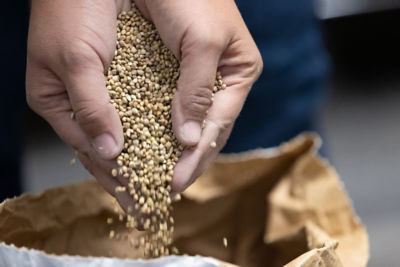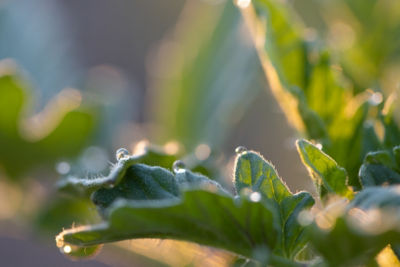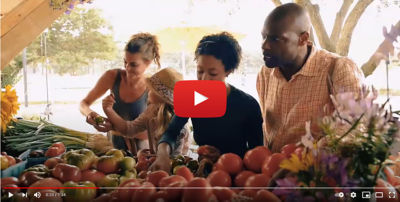Click here to download a PDF version of this Cultivation Insights article.
» Crop rotation is an important strategy for managing some diseases, weeds, and insect pests of vegetable crops.
» Rotating crops also provides nutritional benefits to plants and maintains soil health.
» Plants in the same plant family should be treated as a single rotational group.
Crop rotation involves planting a sequence of different kinds of crops in a location over several seasons/years (Figure 1). Rotating crops helps maintain or improve soil health and maintain or increase the productivity of the farm over time. To get the most benefit from rotation, growers should schedule sequential plantings based on rotational groups of plants belonging to the same plant family (Table 1).1,2 Vegetables belonging to the same family can be considered as a rotational group because they are susceptible to many of the same diseases and insect pests, share similar nutrient requirements, and are treated with similar pesticides.1

Disease Management
Rotation can be used to help manage diseases caused by pathogens that survive in the soil or crop debris and whose populations decline in the absence of a susceptible host.3 Crop rotation is not effective against pathogens that primarily enter fields on air currents, by vectors (such as insects), or on seed. Some pathogens are soil inhabitants that can persist in the soil for many years in the absence of a susceptible host. The populations of these pathogens may not decline with rotation, but rotation can help keep the populations from increasing or slow the rate of increase.3 Some pathogens have wide host ranges that include crops in different rotational groups. Extra care must be used when designing rotation sequences to help manage these pathogens. Grass species, such as corn, wheat, and sorghum, are very different from most vegetable crops and can be good partners in a vegetable rotation sequence.

The amount of time between similar crops needed to manage a disease depends on the pathogens present.3 Some pathogens only remain viable in the soil or infested crop debris for a short time. Rotating away from a susceptible host for one or two years helps reduce populations of the pathogens that cause leaf blight of onion and bacterial spot of pepper, for example. Other pathogenic organisms produce long-term survival structures and require longer rotations to manage. A rotation of two to three years is recommended for managing Fusarium root rot of beans, and a minimum of seven years for clubroot on broccoli and cabbage. The Verticillium wilt pathogen on tomato and eggplant has a wide host range and produces survival structures that can remain viable in the soil for many years. Crop rotation is of limited use for managing this disease.1,3,4
Nematode Management
Many plant pathogenic nematodes are soilborne and can be managed, in part, with crop rotation. Nematodes, such as species of root-knot nematodes, have wide host ranges. Some nematode species can survive as eggs in the soil or as eggs in structures called cysts in the soil for several years. For these nematode problems, it is important to correctly identify the causal agent and to rotate to non-host crops for the time needed to sufficiently reduce the nematode populations.
Insect Management
Unlike soilborne pathogens, many insect pests of vegetables can move easily from field to field. Crop rotation is not effective for managing these pests. However, crop rotation can be used to break the life cycle of insect pests with limited mobility and narrow host ranges. Corn rootworm adult females lay eggs in the soil in corn fields in late summer and early fall. The eggs overwinter in the soil, and larvae emerge in the spring to feed on corn roots if the field has been replanted to corn. If the field is rotated to a non-host crop, the larvae do not have corn roots to feed on and die, breaking the cycle. Other vegetable insects for which crop rotation is useful include wireworms on root crops, sweet corn, and melons; and Colorado potato beetles on solanaceous crops such as eggplant, pepper, potato, and tomato.1,5
Weed Management
Crop rotation can also be used to help manage weed problems because different crops compete with weed species in diverse ways. Crops vary in their time of planting, rate of canopy development, canopy height, row spacings, fertility management, and harvest times. This creates varied environmental conditions that favor different weed species each year, preventing the buildup of a few species. The diversity of weed management strategies used with different crops also increases weed diversity and reduces the prevalence of problem weeds that can build up over time. Varying cultivation practices can disrupt the buildup of problem weed species. Crop rotation also allows the use of herbicides with diverse modes of action, which can prevent the development of herbicide-resistant weed populations.6,7 However, when using selective herbicides, it is critical to consider the effect that herbicide carryover may have on subsequent crops. Many herbicide labels include plantback restrictions, indicating the amount of time that must pass before planting a specific crop following application. Always check pesticide labels for instructions on re-cropping restrictions and follow label directions. Keep crop rotation sequences in mind when selecting herbicides and vice versa.3
Nutrient Use
Crops differ in their nutrient requirements and their abilities to extract nutrients from the soil. Tomato plants are heavy feeders. Celery, by contrast, is not as efficient at extracting soil nutrients, and celery can have problems with nutrient uptake when planted following tomato.1 Legumes (alfalfa, beans, peas) can fix atmospheric nitrogen into the soil increasing soil nitrogen levels. However, legumes that are harvested for seed (soybean) do not provide much added nitrogen to the soil. Growing alfalfa in a field for several years can provide enough nitrogen to meet the needs of the following vegetable crop.3
Example Rotation Sequences
Crop rotation sequences can be simple, alternating between two crops each year (Figure 2) or more complex. Longer, more complex sequences (Figures 1 and 2), especially those that include a year or two of forage crops in the rotation, usually provide the most benefit to production. However, they may not be feasible in all situations, depending on growing conditions and market forces.
 Figure 2. A simple 2-year crop rotation sequence
Figure 2. A simple 2-year crop rotation sequence
SUCCESSION CROPPING AND INTERCROPPING
Succession cropping is the planting of two or more crops in the same location in a single season, such as lettuce planted in the spring, followed by squash in the summer, and then broccoli in the fall. With succession cropping, the same rule of rotation should be followed, including avoiding the use of crops in the same plant family in the sequence.1 Intercropping is the cultural practice of planting two or more crops in the same location at the same time. In this case, it can be best to intercrop members of the same plant family together and consider them as one rotational crop. For example, radishes can be planted between rows of cabbage and broccoli. Spacing and orientation should be designed to allow for adequate light exposure for each of the crops.1
Sources
1Roberts, E. Vegetable rotations-successions and intercropping. Texas A&M Extension. https://lubbock.tamu.edu/programs/crops/vegetables/vegetable-rotations-successions-andintercropping/.
2Fake, C. 2013. Vegetable plant families and their characteristics. University of California Cooperative Extension, Publication Number 31-141C. https://ucanr.edu/sites/placernevadasmallfarms/files/170644.pdf.
3Rudolph, R., Wright, S., Bessin, R., Gauthier, N., Leonberger, K., and Munir, M. 2024. Vegetable production guide for commercial vegetable growers, 2024-2025. University of Kentucky. https://publications.ca.uky.edu/files/ID36.pdf.
4Magdoff, F. and van Es, H. Crop rotations. In Building Soils for Better Crops, 3rd Edition. SARE. https://www.sare.org/Learning-Center/Books/Building-Soils-for-Better-Crops-3rd-Edition/Text-Version/Crop-Rotations.
5Stoner, K. Management of insect pests with crop rotation and field layout. SARE. https://www.sare.org/Learning-Center/Books/Crop-Rotation-on-Organic-Farms/Text-Version/Physical-and-Biological-Processes-In-Crop-Production/Management-of-Insect-Pests-with-Crop-Rotation-and-Field-Layout.
62013. Cultural weed management. NC State Extension.https://soybeans.ces.ncsu.edu/cultural-weed-management/.
7Pittman, K. and Flessner, M. Crop rotations. GROW Integrated Weed Management. https://growiwm.org/crop-rotations-and-planting-date/.
Websites verified 3/4/2025
Additional Information
For additional agronomic information, please contact your local seed representative. Performance may vary, from location to location and from year to year, as local growing, soil and environmental conditions may vary. Growers should evaluate data from multiple locations and years whenever possible and should consider the impacts of these conditions on their growing environment. The recommendations in this article are based upon information obtained from the cited sources and should be used as a quick reference for information about vegetable production. The content of this article should not be substituted for the professional opinion of a producer, grower, agronomist, pathologist and similar professional dealing with vegetable crops.
BAYER GROUP DOES NOT WARRANT THE ACCURACY OF ANY INFORMATION OR TECHNICAL ADVICE PROVIDED HEREIN AND DISCLAIMS ALL LIABILITY FOR ANY CLAIM INVOLVING SUCH INFORMATION OR ADVICE.
5010_527350 Published 03/04/2025



